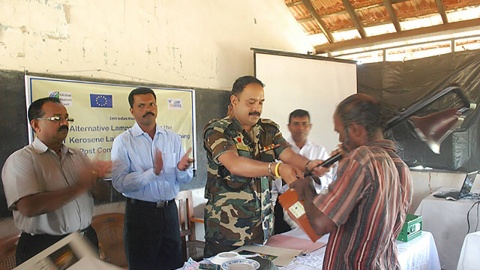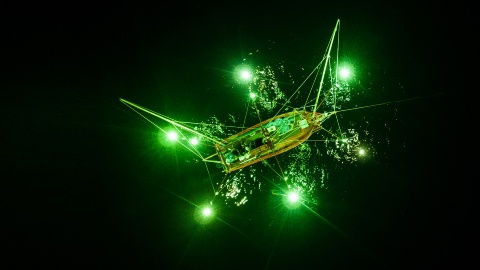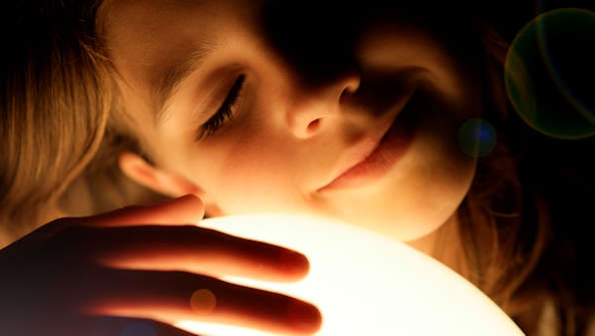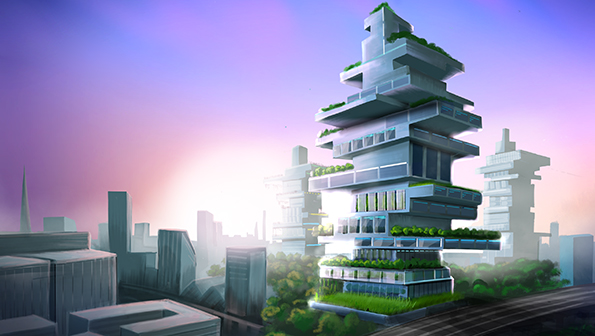
At night the enormous mangrove forests of Sri Lanka are blanketed in deepest darkness. Nothing can be seen, not even the proverbial hand in front of one's face. The stars above are the only point of orientation. Every now and again frogs and other animals can be heard, perhaps the occasional splash of a fish jumping out of the water. Nobody would want to venture out into this swampy maze by the sea at night – at least you wouldn't think so. But here they are: The shrimp fishermen. This is their time. Night after night they pilot their boats through the terrain, dropping their lamps into the water, the light attracting shrimp to be caught in the fishermen's nets.
What looks like a traditional ritual with obsolete technology is actually a sustainable fishing technique – using high technology: The modern LED lamps the fisherman lower into the water are only apparent at second glance. These lamps are gradually replacing the kerosene lamps that are still in widespread use. According to estimates, the 85,000 inland fishermen have in the past consumed 30 million liters of kerosene annually, generating 75,000 tons of CO2 emissions. On top of that, leaking fuel has repeatedly threatened the spawning areas of the shrimp. The inexpensive water-tight LED lamp is a development of specialty light manufacturer Diana Electronic, supported by expertise from Infineon and Osram as a part of the "LED Light for You Initiative". This approach protects the sensitive mangrove forest ecosystem from leaking kerosene and significantly reduces CO2 emissions. At the same time it lets the fisherman continue their night fishing using innovative technologies and thus helps them continue to earn a living.
The story of the shrimp fisherman in Sri Lanka's mangrove forests is part of a worldwide revolution that would be inconceivable without semiconductors. Hardly any other industry sector is being transformed quite as drastically as the lighting industry. Everywhere Light Emitting Diodes (LEDs) are gradually forcing established technologies from the market and are delivering the valuable commodity of light to wherever it's needed. And they're more efficient and more customized than ever would have been possible in the past. One of the things making this possible is the incredible variety of LED modules and components and their diverse application areas.

History of light

Looking back: Even as people began creating the first cave paintings in ancient times, they needed artificial light to see in the dark – and this was no easy thing to do. Under the reign of the "Sun King" Louis XIV the price of candle wax matched the daily wages of a simple tradesman. 200 years later, as the success story of electric light began in the form of the light bulb, the high cost of generating electricity and the associated infrastructure posed enormous challenges to the proliferation of the electric light. For the common man light remained a luxury item for quite some time.
Whether the old kerosene lamps used by the shrimp fishermen or the classic light bulb, most traditional forms of lighting constitute a tremendous waste of energy and resources. According to calculations, today 20 percent of the electricity produced worldwide is used for electric lighting. In The United States alone, the migration to LED technologies over the next two decades will save approximately 250 billion dollars.
The role of LED light in our everyday life

As LED technologies become more and more prevalent, light is taking on a new quality. Light has become a part of everyday life in a diverse range of ways never seen before. The days when light simply made things "brighter" are long a thing of the past. In fact, LED technology offers new possibilities previously unthinkable in the history of artificial lighting. Not only is LED technology more energy-efficient than ever before, it also enables dynamic control: Just the right light at just the right time. Light therapies are also taking on increasing importance in medicine. Pilot projects in health-care facilities have shown that patients sleep better at night if they are surrounded by dynamic lighting during the day. Employers can control the color of light in offices by combining white and colored LEDs and can adapt it to natural daily rhythms. At home we use our smartphones to set the lighting to match our moods or accommodate practical situations, and road traffic is becoming safer due to the constantly increasing strength of automobile headlights and illumination in tunnels.
Light plays a central role in public spaces as well. For years urban planners, architects and sociologists have been addressing the question of how light can improve the quality of life in cities and improve public safety. Efficient, reliable solutions with permanently manageable costs play a central role in all concepts and investment decisions. Here small but crucial details are often decisive in practice. And it's usually semiconductor technology that makes the difference.
How Infineon contributes to LED lighting

Take for example Infineon's ICL5101, a high-voltage resonant controller for lighting systems in the 40 to 300 watt range. The construction of the ICL5101 makes it easier to development cost-effective LED drivers and enables significant cost savings, especially in large-area lighting applications such as industrial and warehouse spaces, office buildings and lighting systems for streets and open public spaces.
Another example is the 60V DC/DC LED driver, a leader in terms of efficiency and current accuracy that helps control light exactly. It's the first component of its kind with an adjustable over-temperature protection feature that keeps the LED from overheating. This protection feature reduces the LED light output when a certain temperature is reached instead of simply shutting off the light. This makes it possible to operate an LED light constantly in non-critical thermal ranges and thus to significantly increase its service life. Another advantage is improved safety: In a roadway tunnel for example the component ensures that lamps retain a constant color even after longer periods of operation and that emergency lighting still works in long-term operation, even in case of overheating.
This revolution has many faces and many heroes who are often only apparent at second glance. The cities of the world are optimizing their lighting infrastructure to be safer and more attractive for their citizens as well as to cut costs. The shrimp fishermen of Sri Lanka on the other hand are mastering the darkness of the mangrove forests. Tomorrow night they'll once again be using their new, customized LED lights to lure the shrimp right into their nets.
Last update: October 2016


